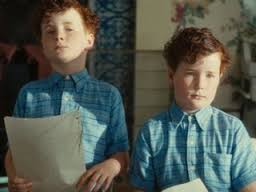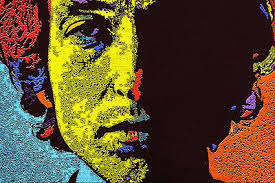Tags
Agatha Christie, Bob Dylan, Castor and Pollux, Detectives, Doppelgangers, Dostoyevsky, Doubles, Harry Potter, Ian McEwan, Inspector Bucket and the Beast, James Hogg, Jekyll and Hyde, Lord of the Flies, Old Testament, Shakespeare, Stephen King, The Detective Club, Tintin, Tweedle dum and Tweedle Dee, Twins, Writing

It was my own twin grandsons that put me on to it.
And we had no preparation whatsoever.
“Mum, Dad,” it was announced to us by my son, “we’re pregnant. It’s twins. And mum, dad, it’s identical twins!”
Yes, it was the birth of my lovely identical twin grandsons, back in May last year, that are to blame for this belated post (in more ways than one). And it was that marvelous occurrence that has lately led me to pondering about twins in literature – of which there are many, of course.
And there are plenty of other people thinking about the same topic too.
Francesca Haig, for instance, in her top ten twin stories for children, lists (amongst others) the Weasley twins from Harry Potter, Golding’s Sam and Eric (“Samneric”) from Lord of the Flies 

and the Thompson Twins (the detectives from Tintin).For some reason she omits the most memorable twins of all (as far as I’m concerned) in failing to mention Tweedle-dee and Tweedle-dum from Lewis Carol’s Alice in Wonderland. However she does include one classic text in her list with her mention of Shakespeare’s Viola and Sebastian, from Twelfth Night – but there were also, of course, Robson and Crane from the Comedy of Errors.The Two Gentlemen of Verona, too, as Louis McConnel argues, is a play that hinges on the twin-like closeness of the relationship between Proteus and Valantine – though the gentlemen are neither twins nor physically similar And there are, indeed many references to the idea of twinning in the imagery Shakespeare uses throughout many of his plays:
“Two cherries on one stem,” for instance, from A Midsummer Night’s Dream and the “Twinned lambs/That did frisk in the sun,” from A Winter’s Tale.
It may be that Shakespeare’s inspiration for using the idea (and actuali ty) of twins and twinning in a number of his plays was, as some scholars argue, because he had twins himself – though non-identical ones in his case – in Judith and Hamnet.
ty) of twins and twinning in a number of his plays was, as some scholars argue, because he had twins himself – though non-identical ones in his case – in Judith and Hamnet.
Ann Morgan, in The Power of Two, offers us a generally more adult list of TwinTales where she includes the supporting role played by the identical twins in Atonement (Ian McEwan), as well as the unnerving twins of Stephen King’s The Shining.

Nick Ripatrazone develops a more classical take on the genesis of twins in myth and story in his On Our Fascination with Twins, where he reminds us of Romulus and Remus

(the founders of Rome); the Biblical Jacob (born holding his twin Esau’s heel) and of Castor and Pollux, the offspring of Leda and Jupiter, when the latter was in swan form. Like Samneric, the Thompson Twins and the Weasleys, Castor and Pollux are notable in that they are essentially the same person (as we seem to routinely expect of twins). But twins, I think, (at least in literature) become more interesting when they are not merely two sides of the same coin and are not there just for comic effect, as they seem to be in Harry Potter or in Tintin. For the truth is no matter how similar they can also be amazingly different.
In Twelfth Night, for instance, it might be argued, that the twins represent not the indivisibility of identity but more a search for a unique sense of self itself. In a more negative way, however, the twin founders of Rome were different enough in that they became enemies and one, indeed, murdered the other. The conflict between Jacob and Essau, some might argue, is the biblical cause of the divisions between Judaism and the so-called Arab world.
Not a good outcome for twins,
It is, however, both the differences and the sameness in twins that make the concept of twins endlessly fascinating. It might be argued (well, here I am doing it)  that the two-in-one character, the chemically induced outcome of Dr Jeckyl’s experiments, is yet another twin story. Jekyll and Hyde stem from the same seed but they are opposites: one evil, one good.
that the two-in-one character, the chemically induced outcome of Dr Jeckyl’s experiments, is yet another twin story. Jekyll and Hyde stem from the same seed but they are opposites: one evil, one good.
The idea of twinned souls is also another way of considering the ‘twin-dichotomy’. Romeo and Juliet, for instance, are not twins in any biological sense but the whole of fate (as Shakespeare makes clear in the Prologue) conspires in their love and their tragic end. They are one soul.

Our recent Nobel Literature Laureate uses this idea in his marvelous Simple Twist of Fate:
“People tell me it’s a sin
To know and feel too much within
I still believe she was my twin, but I lost the ring
She was born in spring, but I was born too late
Blame it on a simple twist of fate”
One might also consider the concept of the doppelgänger as a version of the twin idea. Natural twins, in popular myth at least, support each other and often know what their other half is thinking or feeling – even at great distances.
The doppelgänger, however, less attractively, is a version of you that you may not know about (until it is too late) and one who may deliberately undermine you.
The Doub le by Dostoevsky is a good example of this idea, as is James Hogg’s Private Memoirs and Confessions of a Justified Sinner. In the latter, a seemingly ‘good’ man is tempted by a stranger he meets who appears to be just like himself. The good man is convinced by this stranger that he (the good man) is above normal morality and thus he descends slowly into a kind of Satanic depravity. In the former, the protagonist meets a double of himself in St Petersburg who has set out to destroy his reputation. The protagonist becomes increasingly paranoid and descends into madness.
le by Dostoevsky is a good example of this idea, as is James Hogg’s Private Memoirs and Confessions of a Justified Sinner. In the latter, a seemingly ‘good’ man is tempted by a stranger he meets who appears to be just like himself. The good man is convinced by this stranger that he (the good man) is above normal morality and thus he descends slowly into a kind of Satanic depravity. In the former, the protagonist meets a double of himself in St Petersburg who has set out to destroy his reputation. The protagonist becomes increasingly paranoid and descends into madness.
Of course, none of this has anything to do with the wonderful sprites of life that are my lovely grandsons. We already wonder how can they be identical twins – they are so different. One perhaps a little more robust than the other. One a little more agile. One of winsome demeanour, one like Superman’s alter-ego, Clark Kent. One a good sleeper. One a brilliant waker! They are not to be called The Twins (well not much). Nor dressed the same. Though sometimes they can be. Nor always together when they do things. Though they often are. And of course there will be more of these differences (and samenesses) as time goes on. And I will continue to feel as if I am a bad grandad if I give the wrong answer when asked, teasingly, “Which one is this?”

By the way I notice, on reflection, that I also have dabbled with fictional twins, doppelgängers and the like in my own writing.
In my novel, Inspector Bucket and the Beast, for example, Frederick Dreadnaught, Richard Dreadnaught’s half brother, moves into Richard’s place when Dreadnaught’s father rejects his first son. And Frederick takes on Richard’s identity with near calamitous results for Richard. In another of my stories (The Stranger in his Bed) there is a confusion of identities that might, too, be part of the twin dilemma. One other of my Bucket (short) stories, The Woman Who Fell uses the twin concept as a plot device.

And here I confess that in one of my short stories I am guilty of falling foul of one of the edicts of The Detection Club (Hon. President: Agatha Christie).

Rule ten to be precise.
Although, to be honest, in my Bucket novel I also break rule 8: No Chinaman must figure in the story. And, come to think of it, I also break rule 3 : Not more than one secret room or passage is allowable.
Oh dear.
Mind you, Agatha Christie can’t crow because she broke rule 7 herself:
The detective must not himself commit the crime.
In her own novel, The Murder of Roger Ackroyd …Well, you get the idea.
By the way rule ten is:
Twin brothers (and presumably sisters) and doubles generally, must not appear unless we have been duly prepared for them.
Well, now you are duly prepared.

